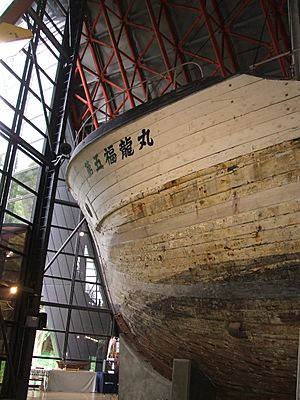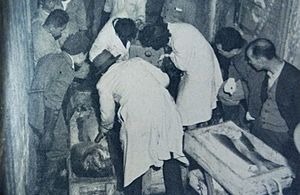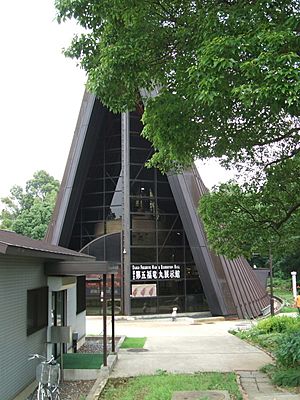Daigo Fukuryū Maru facts for kids

Daigo Fukuryū Maru on display in Tokyo
|
|
Quick facts for kids History |
|
|---|---|
| Name |
|
| Launched | 1947 |
| Status | Museum ship since 1976 |
| General characteristics | |
| Type | Fishing boat |
| Displacement | 140.86 t (139 long tons) |
| Length | 28.56 m (93.7 ft) |
| Beam | 5.9 m (19 ft) |
| Propulsion | 250 hp (186 kW) engine |
| Speed | 5 knots (9.3 km/h; 5.8 mph) |
| Crew | 23 |
Daigo Fukuryū Maru (第五福龍丸, F/V Lucky Dragon 5) was a Japanese tuna fishing boat. It had a crew of 23 men. On March 1, 1954, the boat was covered in nuclear fallout. This happened after the United States tested a powerful thermonuclear weapon called Castle Bravo. The test took place at Bikini Atoll.
The crew became very sick from acute radiation syndrome (ARS). This is a serious illness caused by radiation. They suffered for several weeks after the Bravo test. All but one crew member got better. The boat's chief radioman, Kuboyama Aikichi, died on September 23, 1954. He passed away due to problems from radiation sickness. Kuboyama is seen as the first person to die from the hydrogen bomb test.
Contents
The Boat's Journey and Accident
How the Lucky Dragon No. 5 Began
The Daigo Fukuryū Maru was built in March 1947. It was first called Dainana Kotoshiro Maru. It started as a boat that fished for bonito. Later, it was changed into a tuna fishing boat. In 1953, it moved to Yaizu Port. It was given its new name, Daigo Fukuryū Maru. This means Lucky Dragon No. 5.
The Final Fishing Trip
The Lucky Dragon No. 5 went on five ocean trips. Its last trip started on January 22, 1954. The crew planned to fish near Midway Atoll. But they lost most of their fishing nets. So, they changed course and headed south. They went near the Marshall Islands.
On March 1, 1954, they ran into fallout from the U.S. Castle Bravo nuclear test. This test was at Bikini Atoll. The Lucky Dragon No. 5 was outside the danger zone the U.S. government had set. But the test was much stronger than expected. Also, the weather changed. This blew nuclear fallout, like fine ash, outside the safe zone.
That day, the sky in the west lit up like a sunset. The boat was not damaged by the blast's shock wave. But hours later, white, radioactive dust fell on the ship. This dust was made of radioactive bits of coral and sand. The fishermen tried to leave the area. But it took them almost six hours to pull in their fishing gear. They also had to process the fish they caught. This exposed them to the radioactive dust.
The fishermen even scooped the highly radioactive dust into bags with their bare hands. One fisherman, Oishi Matashichi, said he tasted the dust. He said it was like "powdered snow" but gritty. The dust stuck to their bodies and the ship. It got into their noses and ears. It irritated their eyes. Symptoms of radiation sickness appeared later that day. Because of this, the fishermen called the white ash shi no hai, which means death ash. The ash had dangerous substances like strontium-90 and cesium-137.
The Journey Back Home
On their way back, the crew started feeling sick. This was as early as the evening after they were exposed. They had pain, headaches, and felt dizzy. Their eyes turned red and were itchy. One crewman kept some of the ash to be tested later. He hung it in a pouch near where the men slept.
Later, experts found that the ash came from a hydrogen bomb. This news surprised the Americans. They had kept their nuclear tests secret.
By the third day, the men got small blisters on their bodies. Their faces also started to get dark. A week into their trip, their hair began to fall out. On March 11, the ship hit rough seas. This made them arrive late on March 14. Luckily, this delay kept the contaminated fish on the ship. The next morning, they were able to throw away most of the tuna once they found out about the radiation.
After Returning to Port


After arriving, the men went to the Yaizu Public Hospital. A surgeon put ointment on their faces and sent them home. On March 15, seven crew members were sent to Tokyo University Hospital. There, doctors found their white blood cell count was very low.
A Japanese scientist, Nishiwaki Yasushi, quickly went to Yaizu. He checked the crew and their boat. He realized they had been exposed to radioactive fallout. He wrote to the U.S. Atomic Energy Commission (AEC) for help. The crew had nausea, headaches, burns, and bleeding gums. They were diagnosed with acute radiation syndrome. The U.S. did not respond to Nishiwaki's letters. However, they did send two medical scientists to Japan to help.
The rest of the crew were kept in Yaizu North Hospital. Their clothes and belongings were buried because of the radiation. High levels of radiation were found in the men's hair and nails. So, the hospital had to cut off their hair.
All the men were moved to Tokyo University Hospital. They stayed there for over a year. They had daily check-ups and many blood tests. Their blood cells had dropped a lot. This caused internal bleeding. They had high fevers, nosebleeds, and constant diarrhea. They were given bed rest, antibiotics, and blood transfusions.
Around August 20, Kuboyama Aikichi's health got worse. By August 29, he became very sick with meningitis. He became confused and had to be tied to his bed. Kuboyama then fell into a coma and got pneumonia. On September 23, he died. He was the first crew member to die from problems caused by radiation sickness. The other 22 crew members left the hospital on May 20, 1955. They had yearly check-ups to watch for long-term health problems.
What Happened Next?
Who Was Responsible?
The U.S. government would not share what the fallout was made of. They said it was for "national security." Lewis Strauss, the head of the U.S. Atomic Energy Commission (AEC), said the U.S. was not to blame. He even suggested the Daigo Fukuryū Maru might have been a "spy ship." He thought it was trying to embarrass the U.S.
Later, the U.S. made the danger zone bigger. It turned out that many other fishing boats were also in the expanded zone. About one hundred fishing boats were affected by the fallout. The FDA later put strict rules on tuna imports.
The U.S. paid Kuboyama's family about $2,800 (which would be about $26,700 today). The sad story of the Daigo Fukuryū Maru started a strong movement against nuclear weapons in Japan. People were especially worried that contaminated fish had been sold.
The Japanese and U.S. governments agreed on a payment. Japan received $15.3 million. The fishing industry got $2 million. The surviving crew members each received about ¥2 million (about $5,550 in 1954, or $52,800 today). It was also agreed that the victims would not be called hibakusha (atomic bomb survivors). Japan promised not to ask for more money from the U.S.
In the 1990s, Oishi Matashichi worked to create a memorial for the tuna affected by the fallout. He raised money and built a stone memorial called "The Tuna Epitaph" at the Tsukiji market.
The Daigo Fukuryū Maru After the Accident
When the ship first arrived at Yaizu, it gave off radiation that could be felt 100 feet away. A Geiger counter showed high levels of radiation on the deck. Because of this, the ship was moved and guarded by police. Many items on the ship, even dead cockroaches, had high levels of radiation.
On March 22, people debated what to do with the ship. The U.S. military wanted to take it away. Japanese officials and scientists wanted to keep it for research. On August 22, the Japanese government bought the ship. It was taken to the Tokyo University of Fisheries. In 1956, the ship was fixed up and renamed Hayabusa Maru. It was then used as a training vessel.
The public was very upset about how the government handled the Daigo Fukuryū Maru and its crew. This led to a movement against nuclear weapons and against the U.S. After the ship docked, many groups passed resolutions to limit or ban nuclear testing. After Kuboyama's death, the movement grew even more. In Tokyo, the National Council for a Petition Movement to Ban Atomic and Hydrogen bombs was started. This group began an annual "ban-the-bomb" meeting in 1955.
On June 11, 1970, the Lucky Dragon No.5 was still sitting in a canal. The area was cleaned up and made into a park. The ship was pulled from the water. In 1976, it was put on public display in Tokyo. It is now a symbol against nuclear weapons. You can see it at the Tokyo Metropolitan Daigo Fukuryū Maru Exhibition Hall.
The Lucky Dragon in Media
The 1954 Japanese film Godzilla was partly inspired by this event. The ship also appears on a poster in the 2001 film Godzilla, Mothra and King Ghidorah: Giant Monsters All-Out Attack.
A poem called Japon Balıkçısı (The Japanese Fishermen) was written in 1956 by Turkish poet Nâzım Hikmet Ran about these events.
A short novel, Ash of Bikini, was published in Russian in 1956. It was written by Lev Petrov and Arkady Strugatsky.
Ralph Lapp wrote The Voyage of the Lucky Dragon, published in 1958.
A film version of the events, Daigo Fukuryū Maru (1959), was directed by Kaneto Shindo.
The artist Tarō Okamoto created the painting Moeru hito (Burning People) because of the Lucky Dragon No. 5 incident. He also included the ship in his large painting Myth of Tomorrow in Shibuya railway station.
See also
 In Spanish: Daigo Fukuryū Maru para niños
In Spanish: Daigo Fukuryū Maru para niños


